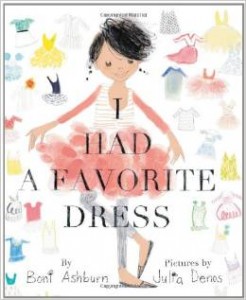 Change is difficult for children. I was delighted to find this aptly titled book : I Had A Favorite Dress by Boni Ashburn and illustrated by Julia Denos. It connected with my own experiences. As a child, I too, had a favorite dress. It had a pale dreamy peach-colored bodice and a white knife-pleated skirt. How I loved that dress and how bereft I felt when I outgrew it. (More than fifty years later I can still picture it and how I felt when I wore it AND when it no longer fit.)
Change is difficult for children. I was delighted to find this aptly titled book : I Had A Favorite Dress by Boni Ashburn and illustrated by Julia Denos. It connected with my own experiences. As a child, I too, had a favorite dress. It had a pale dreamy peach-colored bodice and a white knife-pleated skirt. How I loved that dress and how bereft I felt when I outgrew it. (More than fifty years later I can still picture it and how I felt when I wore it AND when it no longer fit.)
That dress represented so much to me. I felt pretty, stylish and grown up. It gave me confidence which, as a shy child, I valued. When it no longer fit, it was a tangible sign that I was different–older and the things expected of me were different. This both excited and intimidated me. Clothing plays an important role in expressing our individuality–for children and for adults. It’s the packaging we use to present ourselves into the world. So it is no surprise, to some of us, clothing is a Big Deal.
It certainly is to the spunky main character in this charming picture book. (She is unnamed and her ethnicity is open to interpretation. A silver star for diversity.) Like her, I loved “making things” out of stuff. (Still do!) At first, she despairs when her dress no longer fits, but then creativity inspires her! She devises a plan to reinvent her favorite garment and enlist her mother to accomplish the makeover.
With each reinterpretation, the original garment becomes smaller and smaller until barely a fragment is left– only enough to … Well, you’ve got to read the book to learn its final incarnation.
As always, I like to put on my AQ* glasses and view the book through the lens of Adoption-attunement. This book is a fun romp through creative problem-solving. It models a resilience to change without beating kids over the head with the message. (As adoptive parents, we are very familiar with how challenging change can be for our kids!) Kids will enjoy discovering how the little girl creates each new version.
Have some fun as you read the book. Pause to predict how you might reinvent the “dress” at each stage. Ask them to think about something in their own life which they treasure and which they are on the verge of “outgrowing.” How might they redesign it to extend its life? Mother encourages her “not to make mountains out of mole hills.” For kids with temperamental emotional thermostats, this is a way of watching others work through their “disasters.” The story easily lends itself to discussing recycling, and maintaining an attitude of possibility and solutions. Enjoy. I rate this book a five star read.

